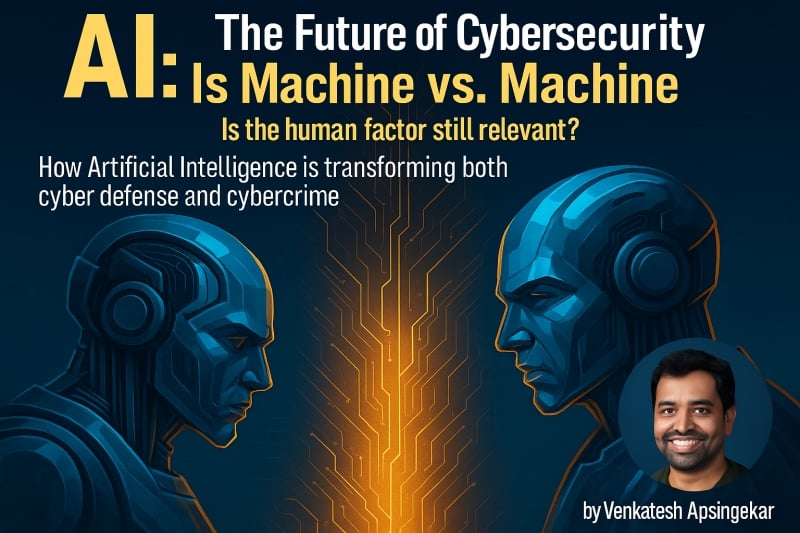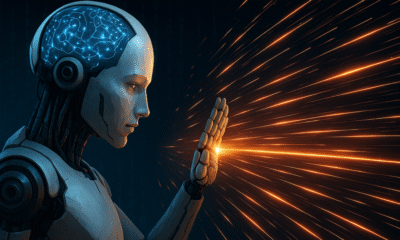Security
The Rise of AI in Cybersecurity: Balancing Machine vs. Human Intelligence

The Impact of Artificial Intelligence on Cyber Defense and Cybercrime
Written by Venkatesh Apsingekar, Senior Engineering Manager at Illumio
Recently, I had the opportunity to watch Terminator 2 with my 9-year-old son. As a cybersecurity professional deeply involved in integrating AI for enhancing threat detection, investigation, and response capabilities, the movie took on a whole different meaning for me. The work I do feels like something straight out of a Sci-Fi film.
Artificial Intelligence (AI) has revolutionized the cybersecurity landscape, turning it into a battleground of AI versus AI. Security products are advancing to detect anomalies, investigate, and respond within milliseconds. On the flip side, cyber attackers are leveraging AI to create malware and personalized phishing attacks that learn and adapt in real-time. This ongoing arms race is shaping the future of cybersecurity.
AI has become a powerful tool with both positive and negative implications, fundamentally reshaping the scale and speed of cybersecurity.
- Speed & Scale – AI can process millions of events and make real-time decisions much faster than human capabilities. This speed also enables attackers to launch large-scale campaigns.
- Accessibility – Open source AI models are readily available, empowering both defenders and attackers.
As a result, both sides are constantly innovating to outsmart each other. Reports indicate that 75% of enterprises are incorporating AI in their security operations, while cybercriminals are openly using AI to launch increasingly sophisticated attacks.
The Revolution in Threat Detection and Investigation
Modern enterprises generate millions of security events daily, overwhelming human analysts. AI-powered security products can process a vast amount of data and make intelligent decisions efficiently.
AI can analyze multiple sources of data simultaneously, such as network flows, user behavior, system logs, and threat intelligence, in a fraction of the time it would take a human analyst. It can identify patterns specific to an organization and detect deviations instantly, like unusual access to sensitive files at odd hours.
Predictive Defense—Anticipating and Preventing Attacks
AI models go beyond reacting to known vulnerabilities by predicting where attacks are likely to occur based on historical data, threat intelligence, and emerging risks. By analyzing global threat data and monitoring new ransomware variants, AI can proactively identify potential threats.
Automated Response: Swift Action in the Face of Threats
According to the IBM Cost of a Data Breach Report 2024, organizations took an average of 204 days to identify a breach and an additional 73 days to contain it, resulting in a total breach lifecycle of 277 days. An AI-driven security platform can automatically respond to threats by isolating infected systems, blocking malicious IPs, revoking compromised credentials, and containing threats in real time.
The Rise of AI-powered Cyber Attacks
Intelligent Malware that Evolves and Adapts
Advanced AI-driven malware, known as “polymorphic” malware, can modify its code structure to evade traditional detection methods. By learning from failed intrusion attempts, this malware continuously evolves and adapts.
Personalized Phishing and Social Engineering
AI has revolutionized phishing techniques by personalizing attacks based on social media profiles, writing styles, relationships, and online behavior. This level of personalization makes it challenging to distinguish between genuine emails and deceptive phishing attempts.
Additionally, AI-powered deepfake videos and voice cloning can impersonate executives, taking traditional “CEO fraud” schemes to new heights.
Automated Vulnerability Exploitation
Using techniques like fuzzing and pattern recognition, AI can exploit software vulnerabilities and infrastructure weaknesses on a large scale, launching attacks efficiently.
The Human Element in Cybersecurity
While AI has significantly impacted cybersecurity, human factors such as context, creativity, and ethical judgment remain crucial. Combining AI’s scalability with human intuition and strategic direction is key to effective cybersecurity.
AI complements the work of security professionals by handling large-scale data processing, allowing analysts to focus on training AI systems, researching new threats, and developing strategic responses.
Conclusion: Navigating the AI vs. AI Landscape
The AI versus AI competition is intensifying, with both attackers and defenders leveraging powerful AI tools. The success lies in effectively training AI systems to stay ahead of evolving threats. Security professionals must strive to keep their AI defenses one step ahead of attackers.
 My Name is Venkatesh Apsingekar, Senior Engineering Manager at Illumio. With nearly two decades of experience in cybersecurity, cloud infrastructure, and data protection, I have worked on Zero Trust architectures, ransomware containment, and large-scale threat detection and response. I hold multiple U.S. patents and have contributed to publications on data security.
My Name is Venkatesh Apsingekar, Senior Engineering Manager at Illumio. With nearly two decades of experience in cybersecurity, cloud infrastructure, and data protection, I have worked on Zero Trust architectures, ransomware containment, and large-scale threat detection and response. I hold multiple U.S. patents and have contributed to publications on data security.
For inquiries, you can reach Venkatesh online at [email protected] or visit our company website at https://www.illumio.com/
Transform the following:
From:
“Please let me know if you need any further assistance.”
To:
“Please inform me if you require additional help.”
-

 Video Games2 days ago
Video Games2 days agoTekken 8: Rise of the Shadows
-

 Video Games1 day ago
Video Games1 day agoGoku Takes on the Dragon Ball FighterZ Arena
-

 Amazon2 days ago
Amazon2 days agoNeil Young Takes a Stand: Pulling Music from Amazon in Protest of Jeff Bezos’ Support for Trump
-

 Tech News2 days ago
Tech News2 days agoSamsung Galaxy UI 8: Embracing the Big Free AI Upgrade
-

 Security2 days ago
Security2 days agoCritical Vulnerability Exposed: Oracle EBS Targeted in Recent Cyber Attacks by Cl0p Hackers
-

 Apple2 days ago
Apple2 days agoExploring the Dystopian Realms of Pluribus: An Apple Original Series Trailer
-

 Microsoft2 days ago
Microsoft2 days agoEnhanced Copilot Features: Creating Office Documents and Gmail Integration
-

 AI1 day ago
AI1 day agoOracle’s Next-Gen Enterprise AI Services Powered by NVIDIA’s Cutting-Edge GPUs






























